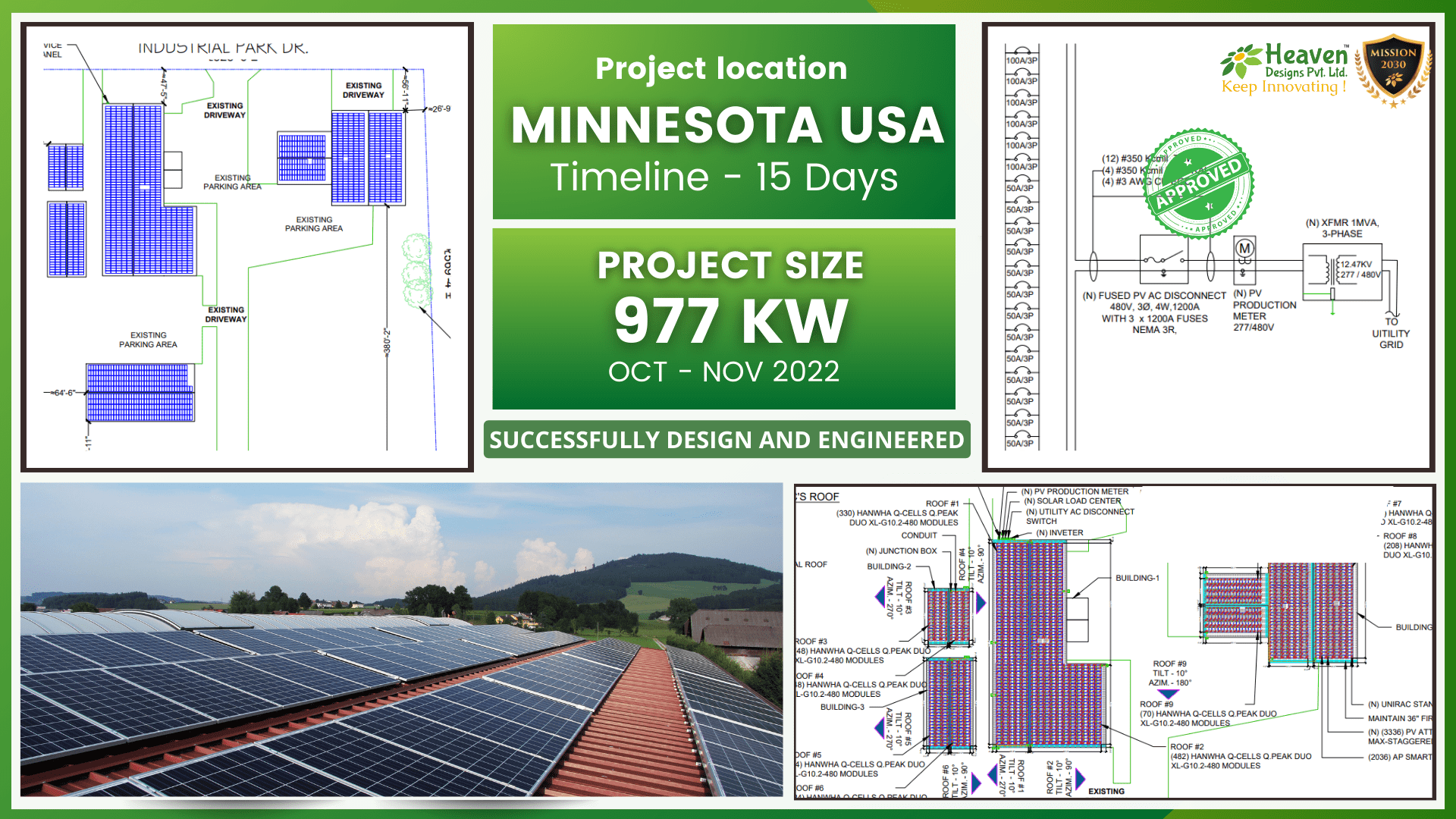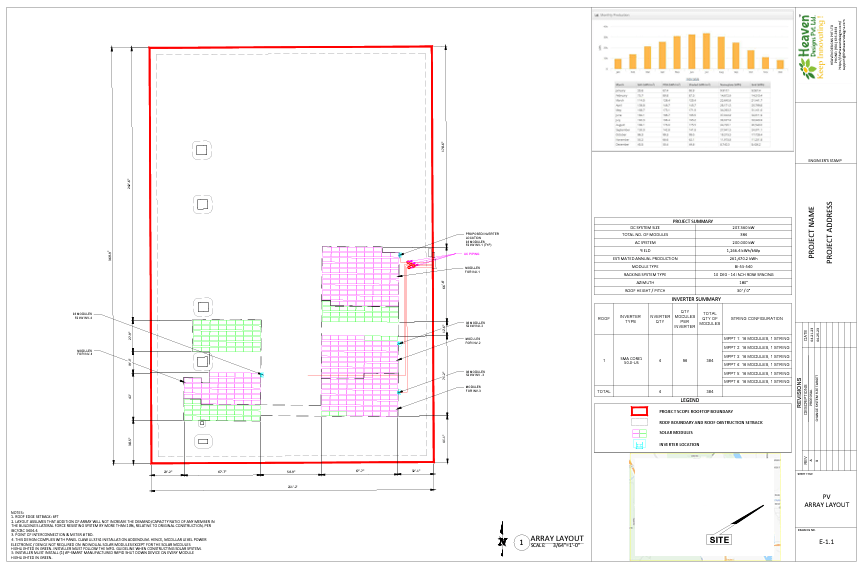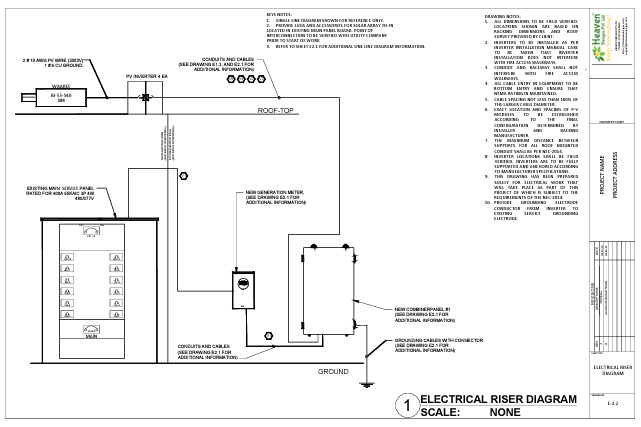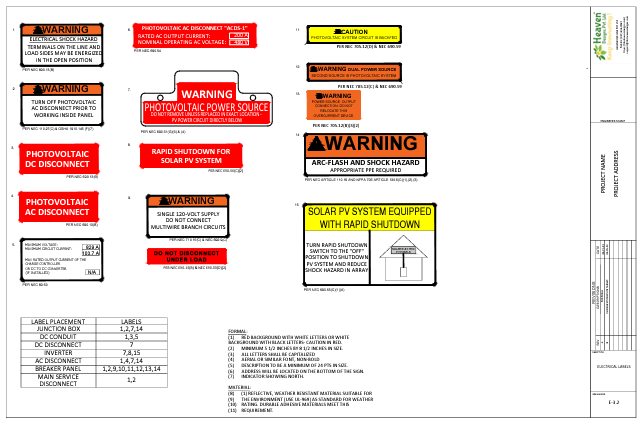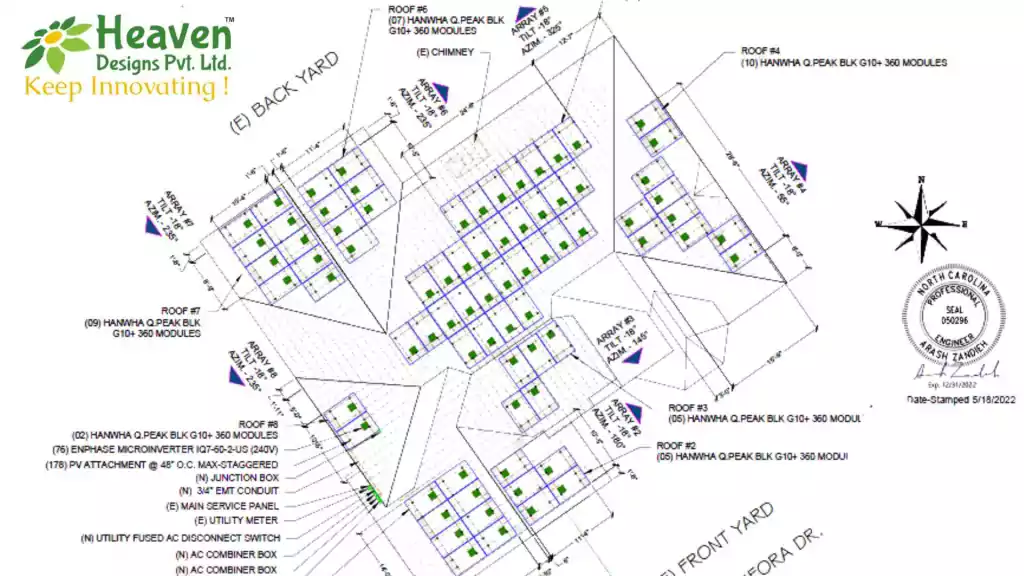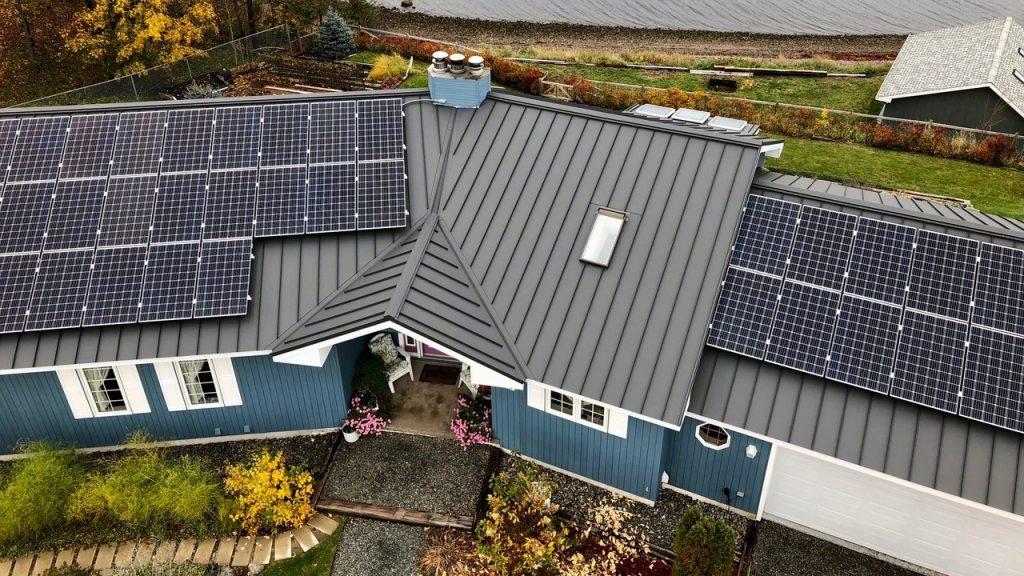Solar Design In the radiant tapestry of sustainable energy, Heaven Designs Pvt Ltd emerges as a maestro, orchestrating success in the completion of the Electro-Solar project in St. Charles, Minnesota. This narrative is not just a case study but a journey through the intricacies of a 977.28 kW rooftop solar installation, where seasoned engineers at Heaven Designs turned challenges into triumphs. Join us in a storytelling expedition where experience takes the lead, transforming rooftops into celestial platforms that power the community of St. Charles.
Project Specifications: Setting the Stage
As we delve into the tale, envision a stage set in St. Charles, Minnesota, with an audience of challenges waiting to be addressed. The cast includes 14 Sunny Tripower Core1 33-US and 7 Sunny Tripower Core1 50-US inverters, 2036 Hanwha Q-Cells Q.Peak Duo XL-G10.2-480 modules, and a standing seam metal roof as the backdrop. Unirac Standard Rail and 18″ O.C. seam spacing enter as supporting characters, each playing a vital role in the unfolding drama.
Act 1: Rooftop Challenges – A Solar Design Odyssey
The curtain rises, revealing the rooftop challenges that presented themselves as a canvas of obstacles. The standing seam metal roof, known for its elegance, demanded a design that respected its aesthetic and factored in load-bearing capacity. Our experienced engineers at Heaven Designs embarked on an odyssey of design precision, leveraging advanced racking systems to harmonize the solar array with the existing structure.
Drawback of Inexperience: The Dance of Uncertainty
Imagine a scenario where inexperienced hands attempt this intricate dance with the rooftop challenges. The lack of seasoned expertise might lead to missteps, marring the harmony between solar design and structural demands. The stage could become chaotic, jeopardizing the success of the entire production.
Act 2: Regulatory Ballet – Navigating AHJ’s Dance
The regulatory landscape becomes a dance between design ingenuity and compliance. Picture our engineers gracefully orchestrating this ballet, securing approvals from St. Charles City AHJ with finesse. The case study unfolds the intricacies of aligning solar design with stringent regulations, turning challenges into an opportunity for a seamless journey from conceptualization to approval.
Benefits of Experience in Solar Design: The Compliance Waltz
Experienced engineers perform a compliance waltz, moving with precision through the intricate steps of regulatory approval. Their seasoned understanding of local regulations ensures a smooth dance, transforming potential stumbling blocks into a seamless journey. Compliance becomes a waltz rather than a stumbling shuffle.
Act 3: Solar design Electrical Symphony – Meticulous Composition
The heartbeat of our solar design for rooftop lies in the orchestration of electrical components. Experienced hands at Heaven Designs meticulously selected inverters and aligned modules for optimal performance. Picture a symphony of electrons conducted by skilled engineers, with the Hanwha Q-Cells Q.Peak Duo XL-G10.2-480 as the virtuoso instruments in this rooftop solar orchestra.
Drawback of Inexperience in solar Design : The Dissonance of Inefficiency
Consider an inexperienced conductor attempting to lead this electrical symphony. The result might be a cacophony of inefficiency, with incompatible components and suboptimal performance. The symphony, instead of harmonizing, may produce discordant notes, affecting the overall energy output.
Benefits of Experience: The Harmonious Orchestra
Experienced engineers, akin to a seasoned conductor, ensure that each electrical component plays its part in perfect harmony. The symphony of electrons flows seamlessly, maximizing efficiency and optimizing energy output. The rooftop becomes a stage for a harmonious orchestra of sustainable energy.
Act 4: Nature’s Waltz – Wind, Snow, and Solar Choreography
Minnesota’s climate introduces its own set of challenges – high winds and heavy snowfall. Experienced engineers at Heaven Designs, akin to seasoned dancers, perform meticulous calculations for wind load resistance and snow load considerations. The solar array becomes a dance floor where 2036 PV modules waltz strategically, optimizing sunlight exposure while harmonizing with nature’s challenges.
Drawback of Inexperience: The Ballet of Vulnerability
Envision an inexperienced dance troupe attempting to navigate the intricate choreography of nature’s challenges. The lack of seasoned expertise might lead to vulnerabilities, with the solar array susceptible to damage from harsh weather conditions. The ballet, instead of grace, may showcase vulnerability, jeopardizing the longevity of the installation.
Benefits of Experience: The Ballet of Resilience
Experienced engineers choreograph a ballet of resilience, ensuring that the solar Design array dances with nature rather than succumbing to its challenges. The strategic placement of PV modules and calculations for wind and snow loads showcase a ballet of resilience, fortifying the installation against the whims of weather.
Act 5: Safety Ballet in solar design – Choreographing Rooftop Harmony
Safety is not just a footnote; it’s a choreographed ballet in our Solar design philosophy. Every element, from ladder placements to rapid shutdown functions, is meticulously crafted by experienced engineers to ensure the safety of installers, maintenance personnel, and emergency responders. Picture safety innovations as dancers move perfectly harmoniously with the solar design, creating a symphony of security.
Drawback of Inexperience: The Risky Tango
Consider an inexperienced dancer attempting the risky tango of rooftop safety. The lack of seasoned expertise might result in unsafe practices, increasing the risk of accidents during installation and maintenance. The tango, instead of being graceful, may become a perilous dance, posing threats to the well-being of personnel.
Benefits of Experience: The Ballet of Safety
Experienced engineers choreograph a ballet of safety, ensuring that every move aligns with the principles of security. From well-placed ladders to rapid shutdown functions, safety becomes an integral part of the rooftop ballet. The installation transforms into a ballet of safety, protecting everyone involved in the solar endeavor.
Act 6: A Detailed Solar Design Symphony – Equipment and Structural Notes
The design process becomes a detailed symphony addressing the challenges of the standing seam metal roof. Advanced tracking systems and adherence to code-compliant installation manuals showcase the commitment of experienced engineers to marry innovation with structural integrity. Unirac Standard Rail and 18″ O.C. seam spacing become the musical notes that echo the excellence of the design composition.
Drawback of Inexperience: The Symphony of Structural Strain
Imagine an inexperienced orchestra attempting to perform a symphony without understanding the intricacies of each note. The lack of seasoned expertise might result in structural strain, compromising the integrity of the installation. The symphony, instead of being melodious, may echo strains of potential failure.
Benefits of Experience: The Symphony of Structural Harmony
Experienced engineers conduct a symphony of structural harmony, ensuring that each note resonates with the strength and integrity of the entire composition. The selection of Unirac Standard Rail and meticulous adherence to structural considerations showcase a symphony where each structural note harmonizes with precision, ensuring the robustness and longevity of the installation.
Benefits of Having an Experienced Solar Design Engineering Team
1. Efficient Problem-Solving: An experienced team brings a wealth of problem-solving skills, enabling swift resolution when unexpected challenges arise.
2. Regulatory Expertise: Seasoned engineers navigate regulatory landscapes with ease, ensuring compliance and expediting approval processes.
3. Optimized Solar Design: Experience leads to optimized designs, maximizing energy output and overall system efficiency. Experienced engineers understand the nuances of component compatibility and system integration, resulting in a well-harmonized solar orchestra.
4. Risk Mitigation: Seasoned professionals anticipate and mitigate risks effectively. Whether dealing with structural considerations or navigating unpredictable weather patterns, an experienced team adds a layer of resilience to the project.
5. Safety Innovation: Designing for safety is an art, and experienced engineers excel in it. They introduce innovative safety measures, ensuring the well-being of installation crews, maintenance personnel, and emergency responders throughout the project’s lifecycle.
6. Swift Adaptation to Challenges: In the dynamic landscape of solar projects, challenges can emerge unexpectedly. An experienced team demonstrates adaptability, swiftly adjusting strategies and overcoming obstacles without compromising project timelines.
7. Cost-Effective Solutions: Years of experience often lead to a keen understanding of cost-effective solutions. From equipment selection to installation methodologies, an experienced team can identify opportunities to optimize costs without sacrificing quality.
8. Efficient Project Management: Seasoned engineers bring a wealth of project management expertise. They understand the importance of timelines, resource allocation, and effective communication, ensuring the project progresses seamlessly from inception to completion.
9. Long-Term Reliability: The longevity of a solar installation depends on the robustness of its design. An experienced team focuses on long-term reliability, incorporating measures that enhance the system’s durability and reduce the need for frequent maintenance.
10. Client Satisfaction: Ultimately, an experienced engineering team contributes to client satisfaction. The ability to deliver a project efficiently, safely, and with a focus on long-term performance ensures that clients not only receive a functional solar installation but also enjoy peace of mind.
Curtain Call: Symphony of Experience by Heaven Designs Pvt Ltd
As the Electro-Solar project in St. Charles radiates energy, it’s not just about watts and kilowatts; it’s about the meticulous design details that transformed rooftops into celestial platforms. This case study is not merely a recounting of challenges overcome but an invitation into the intricate expertise of experienced engineers at Heaven Designs Pvt Ltd.
In the grand finale, the benefits of having an experienced engineering team take center stage. The efficient problem-solving, regulatory expertise, optimized design, risk mitigation, safety innovation, swift adaptation to challenges, cost-effective solutions, efficient project management, long-term reliability, and client satisfaction collectively create a symphony of success.
The experienced engineers at Heaven Designs Pvt Ltd not only met the challenges posed by the Electro-Solar project but elevated the entire performance to a crescendo of excellence. The rooftop became a stage where each note of the solar orchestra played harmoniously, showcasing the benefits that only experience can bring to the forefront.

